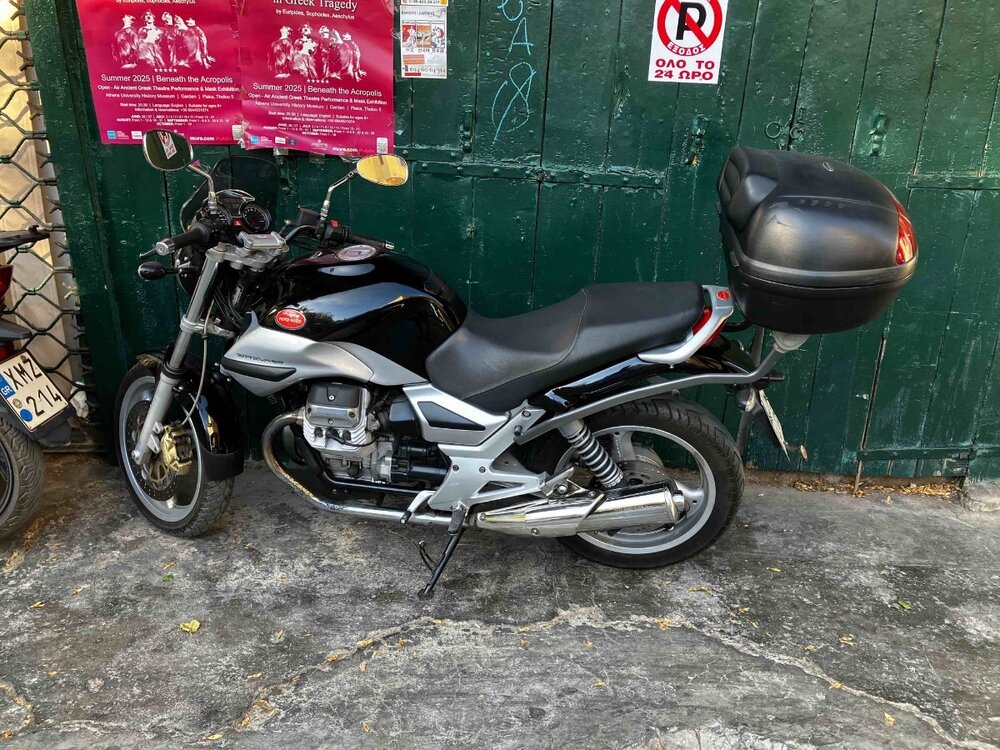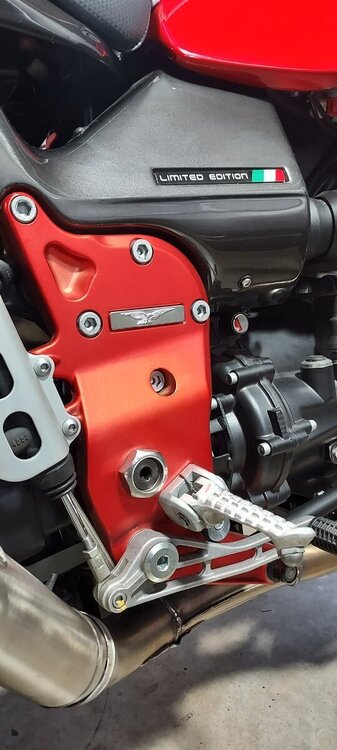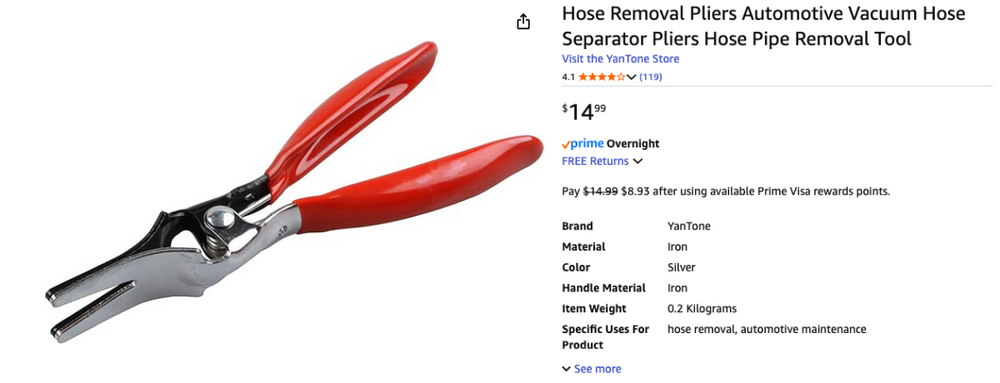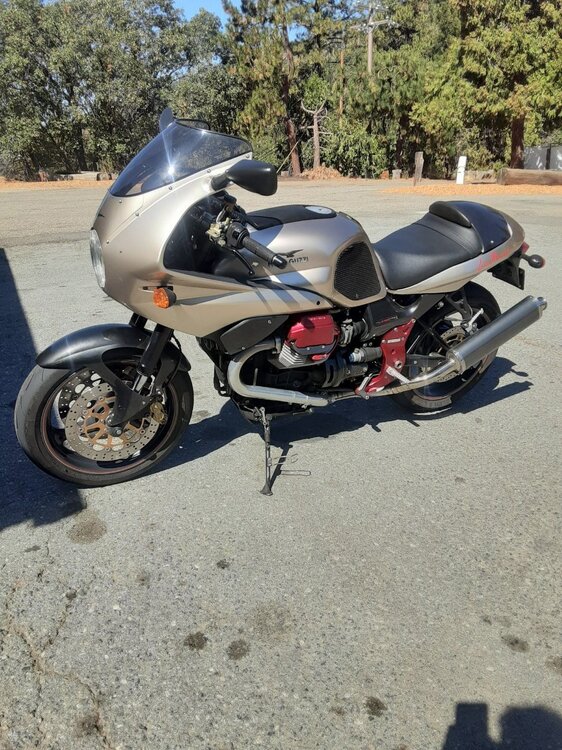Leaderboard
Popular Content
Showing content with the highest reputation on 10/08/2025 in Posts
-
7 points
-
Well, the oil pressure light...definitely needs investigation. I know you have the means to test the switch, thread it into something and check action with air pressure. If the switch passes the testing, you're into the bottom end somewhere- hopefully just the oil filter loose? My first thought with the sputter stall was 'cam sensor fail'. If it was very hot, such as idling in traffic when it quit, then cooled and rode home in the wind, consider it. Monitor with heat in mind if future similar events. In reality, any failure in about 70% of the connections in the harness could cause this. Relays, ignition switch, run/sidestand/clutch switches, fuel pump connections, battery terminals... My 'Sport was hinkey half the time until I literally swept the entire harness from front to back with DeOxit, cleaned the inside of the ignition switch, added the extra grounds, et al. Now it simply works as intended.4 points
-
Well there's the crux of it. Music isn't sensible. So we didn't convert to a system that accommodates both Beethoven and Thelonious Monk.3 points
-
Fantastic. Can I use that? It would be very often useful to "explain" the behaviour of sound equipment.3 points
-
Exactly. The sensor itself is an analog device, sending an alternating current waveform. The AC voltage, at a given RPM, will increase or decrease nearer or farther. The waveform is seen as a simple +/- by the digital electronic device served by the sensor. There is a minimum voltage to trigger the electronics (the measure of which escapes me at the moment) and once they're triggered, they really don't care how much extra is there. If the sensor gets too far away, such as if an ABS sensor gets debris or loose wheel bearings that increase the distance to reluctor, the voltage becomes marginal or intermittent to trigger the electronics so you get...the scientific term is 'intermittent wonkiness' I think.3 points
-
2 points
-
As far as I understand it, no "tuning" effects. Either it works satisfactorily, or it doesn't, i.e. under a particular value, the pulse is too weak. Above that, it is enough, but "more" doesn't make it better. The ECU sees the pulse, or it doesn't. What is that in sensible units?2 points
-
2 points
-
If memory serves, (Bendix factory brakes training) *all* simple coil-type inductive sensors are set at .030" +or- .010". So that's supported by this spec.2 points
-
2 points
-
You have two issues to address; As Roper,Tinus , I and others will verify , this light is not "for entertainment purposes only". Replace the oil press. switch and go looking. Remove the manhole cover and take off the filter and inspect the seal on the filter. Install a new filter / oil. Get this filter SNUG. when you install the manhole cover push against the pan and rotate it like you are removing it . When it clicks , stop turning and tighten it. This way you will not cross thread it. Install a new o-ring on the cover too. The majority of engine failures come down to loose oil filters. these are inside the oil pan and impossible to know if they are tight/loose until something bad happens. we don't want you to have a 500lb piece of junk in your yard. It is not easy coming up w/another engine.2 points
-
The factory manual gives 0.6-1.2mm clearance or 0.023-0.047" clearance. IDK what the hot setup is. I would think the 0.7mm clearance is the best. You want the tooth to be in the center of the bore when measuring this clearance.2 points
-
What about adding, to the ethanol-free fuel, a product like "Sta-Bil" fuel stabilizer?1 point
-
Why not? If you can deal with Guzzi electrics, reading music should be easy as pie.1 point
-
1 point
-
I like how these guys follow “The "rules" of western tonal music”1 point
-
Haha - yeah, "music is just A-B-C-D-E-F-G" as some smartaxx musician once told me. But, like, NEVER in that order. I thought neurophysiology was complicated. Until I picked up string instruments.1 point
-
I beg to differ. The "rules" of western tonal music adhere to strict rules that are based in physics. Believe me, I have a Bachelor degree in music with a focus on 20th century music. Quite apart from that, it seems to me a paradox that the U.S.A. staged an heroic revolution to release themselves from the yoke of british imperialism, but didn't go the whole 9.144 metres and adopt the much more logical and sensible system that was proposed in France about a century earlier, and finalised about the same time as the revolution. PS: Australia is still nominally a "British Colony", but the sensible system of measurement was adopted about the end of the '60s, when I was about 7 years old.1 point
-
1 point
-
1 point
-
So, as long as they are in the specified range, the trigger has the same outcome? In other words, there would be no "tuning" effects to setting it close versus furthest out in the specified range?1 point
-
Well... well. Yes, they induct by the square of the distance. This obviously means they generate the strongest signal set to zero; actually some ABS sensors are set this way, push them in against the reluctor and the bearing clearance pushes them out just enough not to rub. They are designed particularly for this. However, the electronics that the sensor serves are perfectly happy at anything less than about .060" (generally) and .030" guarantees that they won't rub the reluctor and self-destruct.1 point
-
So.... it induces or it doesn't? Not like you can get more or less induction by setting it closer or further?1 point
-
Sorry for my absent reply, I've been in Greece the past few weeks! It sounds like you have this covered now, no?1 point
-
That depends on the fault. Assuming it did have something to do with that switch, the bike ran again later, so it can be considered an intermittant fault. I gather the bike was rolling when it died. So if the switch was cutting in and out, the momentum could easily have "push started" the bike a couple of times before it finally died. All crystal ball stuff from here, but it seems plausible to me. Since you worked on and around the switch recently, and now the motor is cutting out, I would definitely have another look at it and make sure it went back together properly.1 point
-
1 point
-
G'day Mick Yep, back in 2011 the gap on mine was 1.4mm and reduced to 0.7mm! Cheers1 point
-
If you rerouted the wire of the side stand, you might check ifnit is not stuck and somewhat dismantled under the generator cover. Dont ask how I came up with this idea.1 point
-
If the oil light came on briefly it’s bad news. It is likely low on oil. Does it have a sloppage sheet fitted?1 point
-
Firstly, and easiest to check: the switch on the side-stand, the switch on the clutch, the kill-switch. All those "safety features" that will stop the motor if they have a fault. Check them and make sure there is nothing dodgy, and take it from there. Oh, and have a look inside the ignition switch. After that, the relays, primarily those involved in the safety features. But as @gstallons already wrote, there is a whole list of things it could have been. Maybe even "only" a bit of water in the fuel tank.1 point
-
Today I took the timing sensor out. Lots of buggerising around: I replaced the breather hose that runs under the spine from the headstock to the back of the motor a while back. It seems I made a "tactical error" in the process. The cable from the timing sensor went up between that hose and the frame, and the connector was hidden under the airbox. The result was that getting the sensor out involved "unclothing" the Le Mans all the way down to unfastening the airbox. When it goes back together, that plug will be nicely accessible on the frame just above the sensor, don't you worry. The sensor didn't look too bad, but it will be swapped out. Holding the new one against the old one, and assuming they were both the same length in new condition, it seems the old one has swelled and shortened such that it is about a half a millimetre shorter than new. That would be enough to take the gap from (assuing it was correct) about 0.7mm to about 1.2mm. Going by what I have read here, amongst others from @guzzler's report on the subject, that would be enough to make it run badly. Whatever, the new sensor will go in. Cleaning up around the sensor was a pain. There were liberal amounts of some sort of silicon sealant involved, and getting that all cleaned up took a while. Since the airbox is now unfastened, the list of "things to be done now" has grown again. I wanted to just put the new sensor in, and see how that affects the way the bike runs. Since I'm so far in now, it seems sensible to go at the "tank off mainenance" thing again from scratch. I've been through that once already, but it was all a bit perfunctory. Since I've got it all apart again, it seems sensible to go at it again and take a bit more care about it. Cleaning the throttle bodies really properly, for instance, And I've got some new rubbers for between the throttle bodies and the motor. And I've got a new timing chain here, and whilst I'm in there I could repair the two broken screws of the four that hold on the alternator cover. And the tailpiece is off, to make it easier to get to the screws for the sidecover. Since that's off, I could have another look at the wiring under the seat, particularly on the underside of the relay sockets. And while I'm in there, I could consider adding the additional relay to supply direct power from the battery to the starter solenoid. The fun never ends...1 point
-
1 point
-
1 point
-
@Sempervee1 thanks for that. I didn't know those existed. Might go looking for one of those, too. Getting the fuel lines of the taps on the V35 Imola is always a bit of a pain, and that looks like the tool for the job.1 point
-
1 point
-
1 point
-
1 point






















